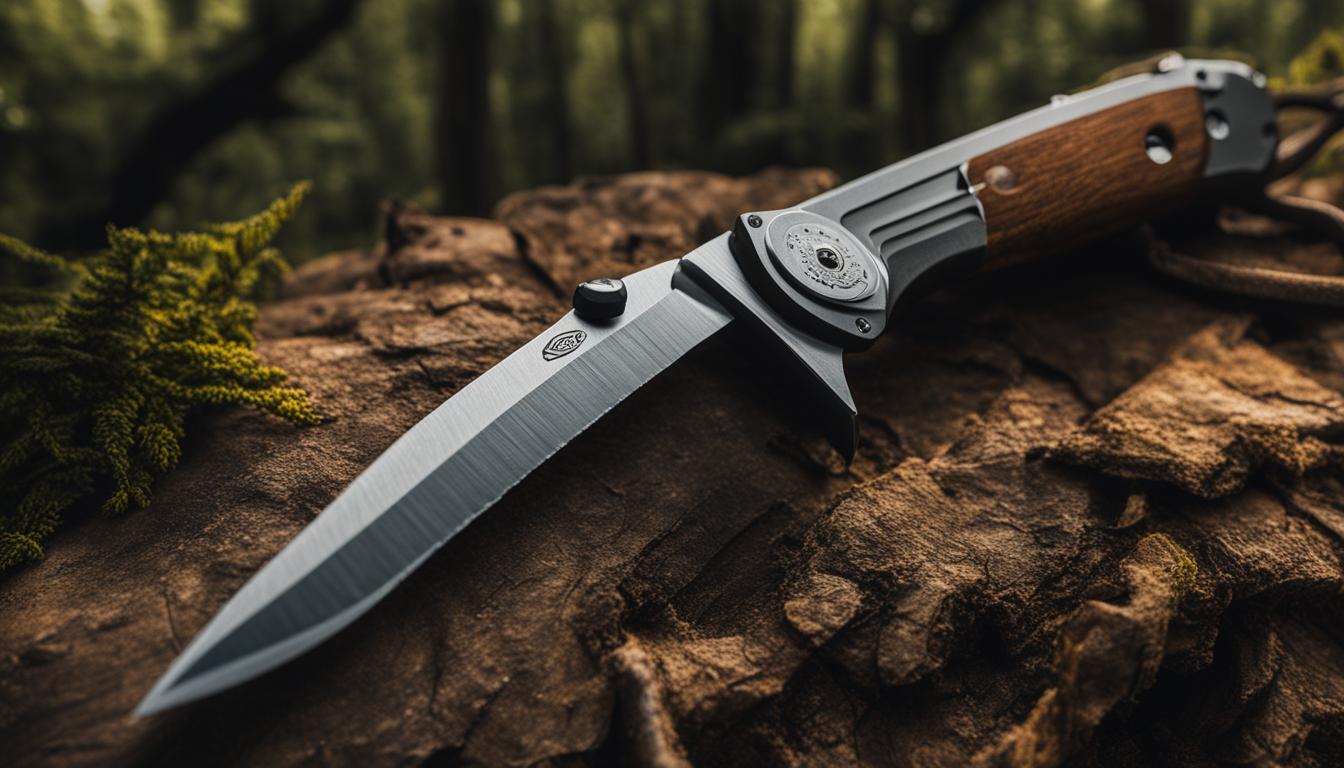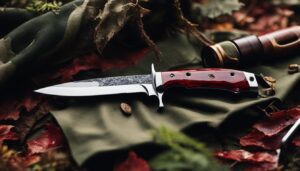When it comes to selecting a hunting knife, size matters. Understanding the size limits and restrictions that apply can make a significant difference in your field performance. The right knife size ensures optimal usability and functionality, enhancing your hunting experience. Whether you’re pursuing game or engaging in specific tasks, knowing the maximum dimensions allowed for hunting knives is essential. By being aware of the size limits and choosing a knife that meets your needs, you can make an informed decision and equip yourself with the perfect hunting tool.
Key Takeaways:
- Consider the size restrictions and maximum dimensions that apply to hunting knives.
- Choose a hunting knife that suits your specific hunting needs and preferences.
- Understanding the size limits ensures optimal field performance and usability.
- Take into account the type of game being hunted and the tasks to be performed.
- Select a hunting knife that meets your requirements for functionality and comfort.
Factors to Consider in Knife Selection
When selecting a hunting knife, there are several important factors to consider in order to ensure the right fit for your needs. One of the most crucial considerations is determining the appropriate knife size based on the intended use. Different hunting scenarios may require different knife sizes, so it’s important to take into account the type of game you’ll be hunting and the specific tasks you’ll be performing. For example, a larger knife might be better suited for field dressing, while a smaller knife may be more maneuverable for detailed skinning tasks.
In addition to size, it’s also important to choose the right blade shape and size for the job at hand. Different blade shapes are designed for specific cutting tasks, such as skinning, quartering, or caping. For instance, a drop point blade is versatile and suitable for a variety of tasks, while a trailing point blade is ideal for precise slicing. By considering the specific tasks you’ll be performing during your hunting excursions, you can select a knife with the appropriate blade shape and size to ensure optimal performance.
When selecting a hunting knife, it’s crucial to consider the game-specific requirements as well. Different types of game may require different knife characteristics. For example, larger game may require a stronger, more durable knife to handle the heavier tasks associated with field dressing. On the other hand, smaller game may require a more delicate knife for precision work. By understanding the specific requirements of the game you’ll be hunting, you can choose a knife that is best suited for the task.
Game-Specific Knife Selection
Game-specific knife selection is a crucial aspect of choosing the right hunting knife. Each type of game presents its own unique challenges and requirements, and selecting a knife that is tailored to those requirements can greatly enhance your hunting experience. Consider the following guidelines for game-specific knife selection:
- For large game such as deer, elk, or bear, a larger knife with a strong, sturdy blade is recommended for field dressing and processing.
- For small game like rabbits or birds, a smaller, more nimble knife with a thinner blade is preferable for precise skinning and detail work.
- For fish, a fillet knife with a flexible blade is ideal for efficiently filleting and cleaning the catch.
- For versatile hunting situations where you may encounter a range of game, a medium-sized knife with a versatile blade shape, such as a drop point, can be a good all-around option.
By considering the game-specific requirements and choosing a knife that aligns with those requirements, you can ensure that your hunting knife is optimized for success.
| Game Type | Ideal Knife Characteristics |
|---|---|
| Large Game (deer, elk, bear) | Larger size, strong and sturdy blade for field dressing and processing |
| Small Game (rabbits, birds) | Smaller size, thin and nimble blade for precise skinning and detail work |
| Fish | Fillet knife with a flexible blade for efficient filleting and cleaning |
| Versatile Hunting (various game) | Medium size, versatile blade shape such as drop point for all-around use |
Understanding Blade Types and Materials
When it comes to hunting knives, understanding the different blade types and materials is essential in making the right choice for your needs. Blade types can vary greatly and each has its own advantages and disadvantages. Two common blade types for hunting knives are fixed blade knives and folding knives.
Fixed blade knives: These knives have a solid, non-moving blade that provides strength and reliability, making them suitable for heavy-duty tasks. They are generally more durable and easier to clean than folding knives. Fixed blade knives are ideal for tasks that require a strong and stable blade, such as field dressing and gutting game.
Folding knives: Folding knives are compact and offer portability and convenience. They have a hinge that allows the blade to fold into the handle, making them easier to carry and store. Folding knives are versatile and can be used for various hunting tasks, including skinning and campsite chores. However, they may have a slightly weaker blade compared to fixed blade knives.
When choosing a hunting knife, it is also important to consider the blade material. Different materials offer varying levels of sharpness, corrosion resistance, and edge retention. Common blade materials for hunting knives include stainless steel, carbon steel, and high-carbon stainless steel.
| Blade Material | Pros | Cons |
|---|---|---|
| Stainless Steel | Good corrosion resistance | Less sharpness and edge retention compared to carbon steel |
| Carbon Steel | Sharp and easy to sharpen | Prone to rust if not properly cared for |
| High-Carbon Stainless Steel | Combines the sharpness of carbon steel with the corrosion resistance of stainless steel | May be more expensive |
Choosing the right blade type and material depends on factors such as the specific hunting tasks you’ll be performing, personal preferences, and budget. Consider the intended use of the knife and the conditions in which it will be used to make an informed decision. By understanding the pros and cons of different blade types and materials, you can select a hunting knife that meets your specific requirements and enhances your overall hunting experience.
Hunting Knife Handle Ergonomics and Material Options
When it comes to choosing the perfect hunting knife, the ergonomics of the handle and the material it is made of are crucial factors to consider. The handle of a hunting knife plays a significant role in providing a comfortable grip, ensuring precision, and reducing fatigue during extended use in the field.
When evaluating handle ergonomics, it is important to consider the shape and texture. A well-designed handle should fit comfortably in your hand, allowing for a secure grip even in wet or slippery conditions. The shape of the handle should provide proper balance and control, reducing the risk of slipping or accidents. Additionally, the texture of the handle should offer adequate grip without causing discomfort or blisters over time.
Handle materials for hunting knives vary, with each offering its own advantages and considerations. Some popular options include wood, rubber, polymer, or G10. Wood handles often provide an attractive and traditional look, but they may require more maintenance to prevent damage from moisture or exposure. Rubber handles offer excellent grip and shock absorption, making them ideal for rugged conditions. Polymer and G10 handles are known for their durability and resistance to wear and tear.
| Handle Material | Advantages | Considerations |
|---|---|---|
| Wood | Attractive, traditional look | Requires maintenance, susceptible to moisture damage |
| Rubber | Excellent grip, shock absorption | May become sticky or collect debris over time |
| Polymer | Durable, resistant to wear and tear | Can feel less natural in hand |
| G10 | Tough, lightweight, resistant to chemicals | Can be more expensive |
Ultimately, the choice of handle material will depend on personal preference, intended use, and the specific demands of your hunting adventures. It is essential to select a handle material that offers a comfortable grip, durability, and meets your individual needs.
Conclusion
Choosing the right hunting knife is essential for achieving optimal field performance. By considering a range of factors, hunters can ensure that they select a knife that meets their specific needs and preferences. Size limits play a crucial role in determining the usability and functionality of a hunting knife. By understanding the size restrictions and maximum dimensions that apply, hunters can make informed decisions and choose a knife that suits their requirements.
Along with size limits, other factors such as blade types and materials should be taken into account. The choice between fixed blade and folding knives depends on the intended use and the level of portability desired. Additionally, the selection of blade materials, such as stainless steel or carbon steel, impacts factors like sharpness and corrosion resistance. By carefully considering these factors, hunters can choose a knife that offers the right balance of strength and durability.
Ergonomics and handle materials also play a significant role in the usability of a hunting knife. A comfortable grip is essential for precision tasks and extended use. By considering the shape, texture, and material of the handle, hunters can ensure a secure and comfortable grip in various conditions. Different handle materials offer different levels of durability, grip, and aesthetics, allowing hunters to select a knife that suits their personal preferences.
Overall, selecting the right hunting knife involves considering size limits, blade types and materials, and handle ergonomics. By following these tips and taking these factors into account, hunters can choose a knife that enhances their outdoor experiences and ensures optimal field performance. So, when it comes to selecting a hunting knife, remember to consider size limits and choose the knife that fits your needs and preferences for the best hunting experience.
FAQ
What factors should I consider when selecting a hunting knife?
When selecting a hunting knife, it is important to consider factors such as the type of game being hunted, the specific tasks that will be performed, and personal preferences. Additionally, the blade shape and size should also be taken into account.
What are the different blade types and materials available for hunting knives?
Hunting knives can come in fixed blade or folding blade options. Fixed blade knives are known for their strength and reliability, while folding knives offer portability and convenience. Blade materials commonly used include stainless steel, carbon steel, and high-carbon stainless steel.
How important are ergonomics and handle materials when choosing a hunting knife?
Ergonomics and handle materials play a crucial role in the usability and comfort of a hunting knife. A comfortable grip is essential for precision tasks and extended use. Different handle materials, such as wood, rubber, polymer, or G10, offer different levels of durability, grip, and aesthetics.
What are the size limits for hunting knives?
The size limits for hunting knives depend on various factors, such as local regulations, the type of game being hunted, and personal preferences. It is important to understand and comply with any size restrictions that may apply in your hunting area.
How can I choose the perfect hunting knife?
To choose the perfect hunting knife, consider factors such as size limits, blade types and materials, and handle ergonomics. By understanding your specific needs and preferences, you can select a knife that maximizes field performance and suits your requirements.





